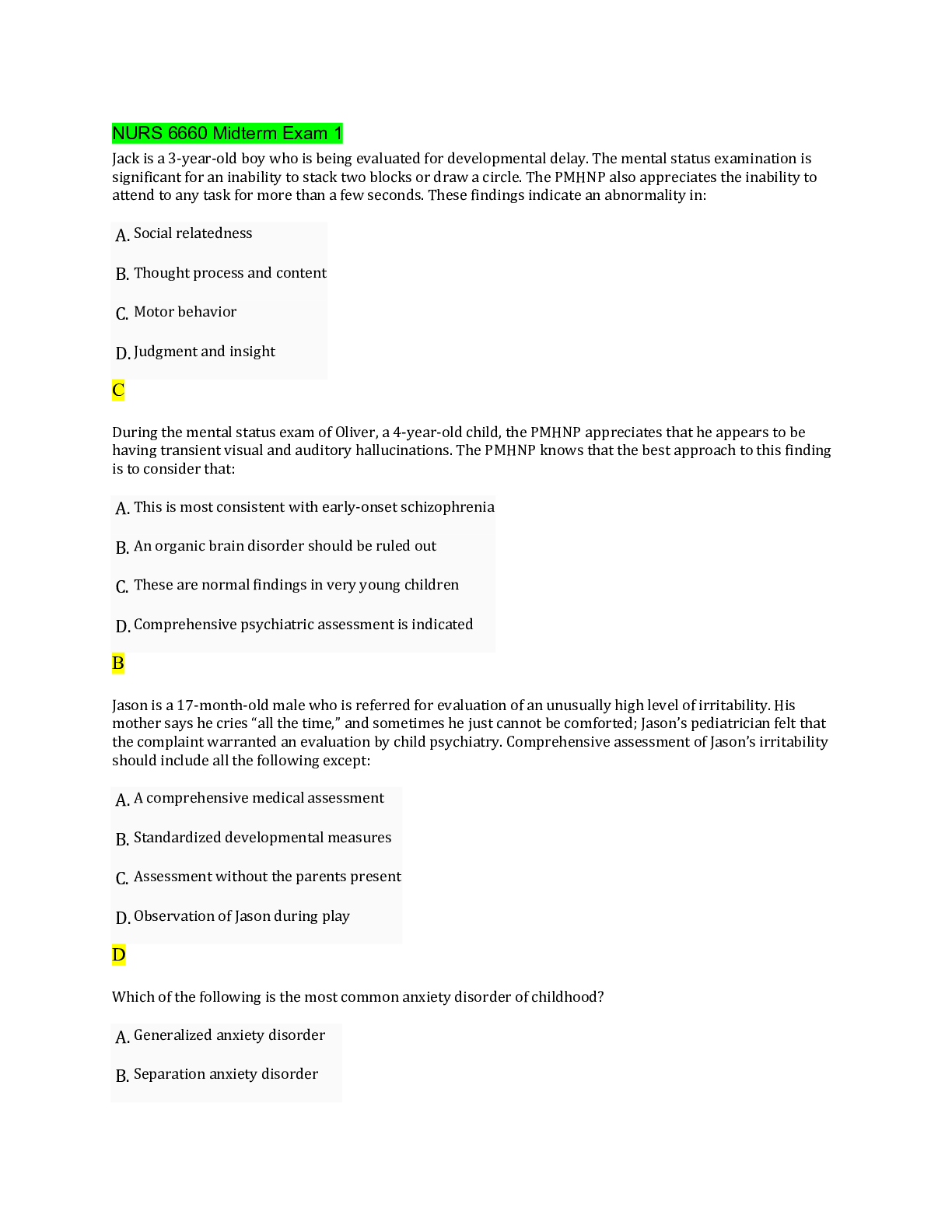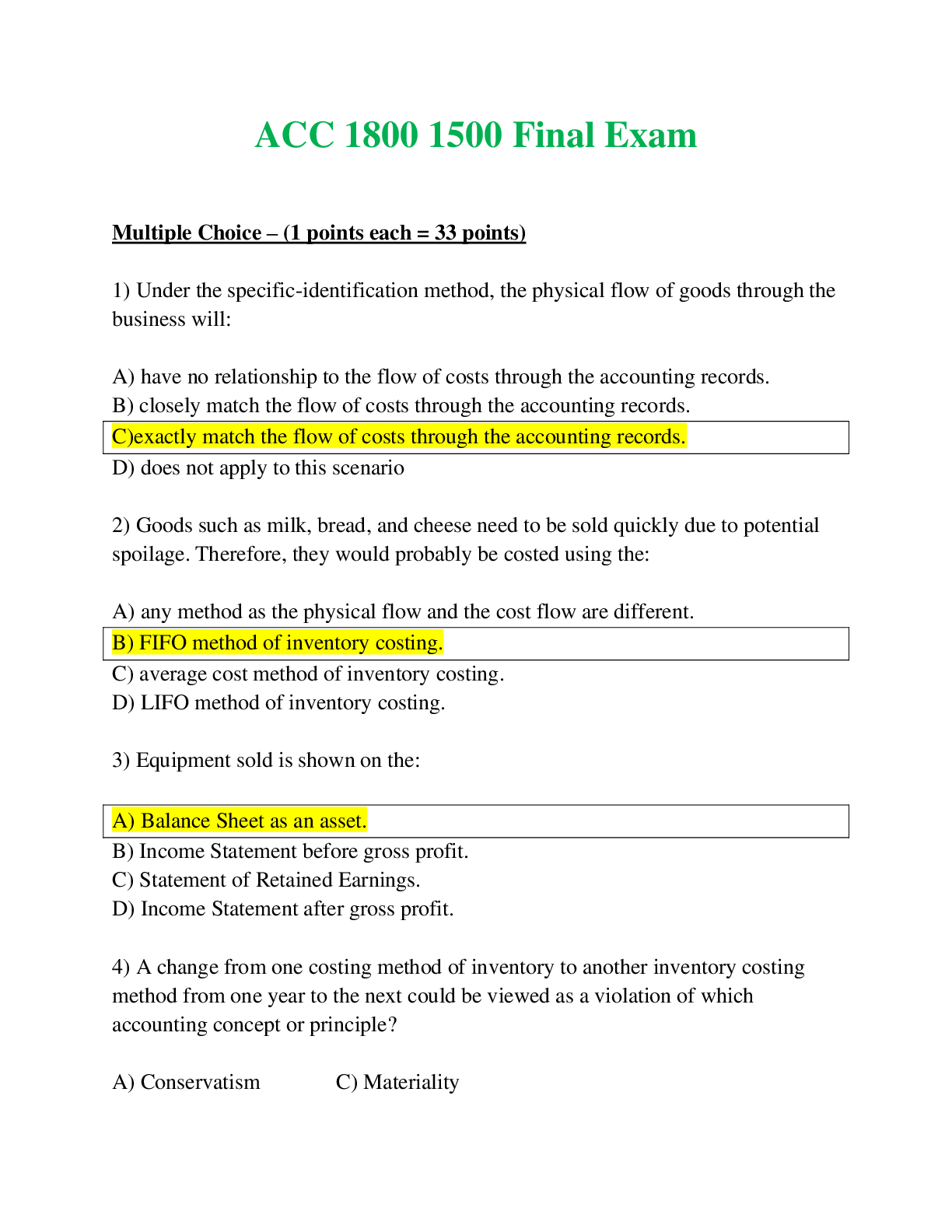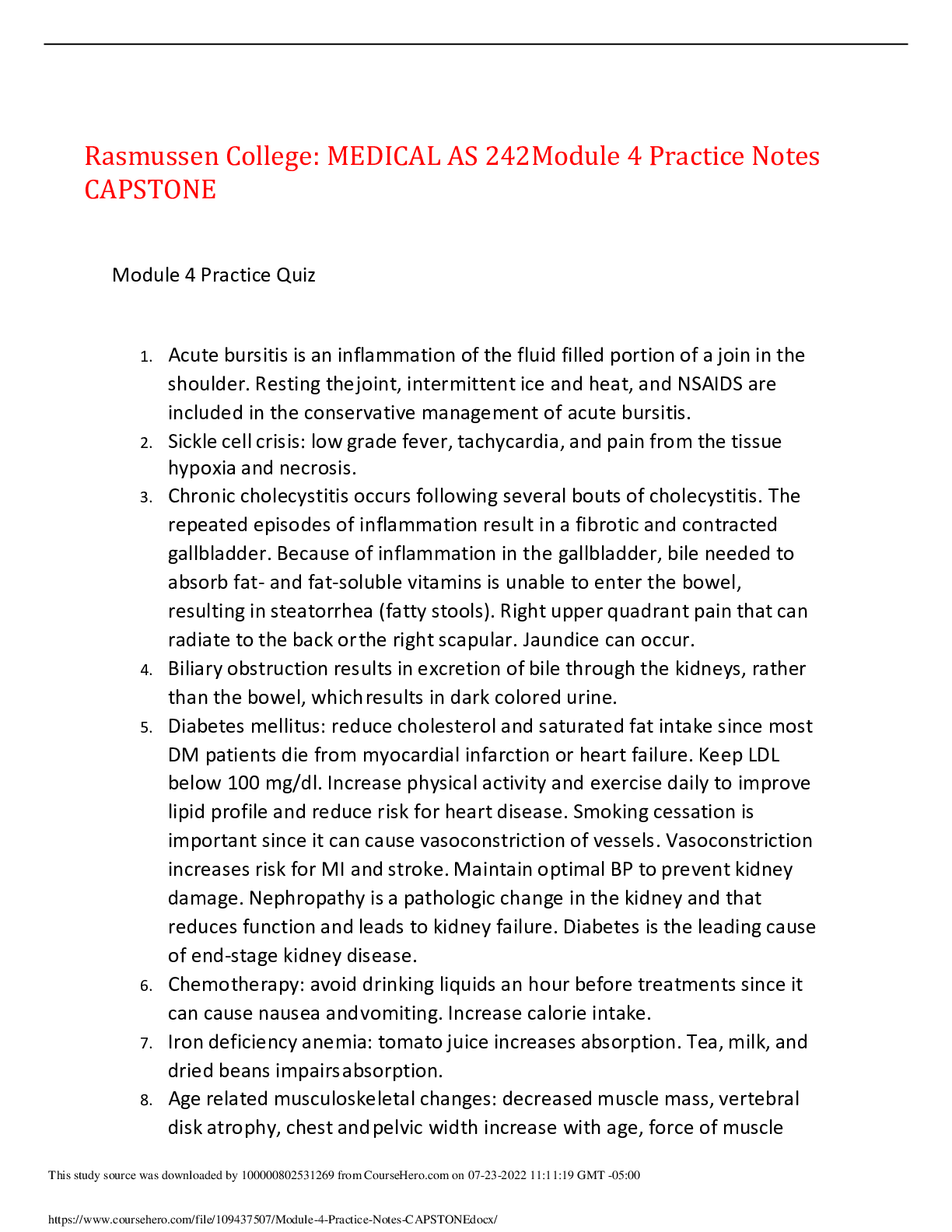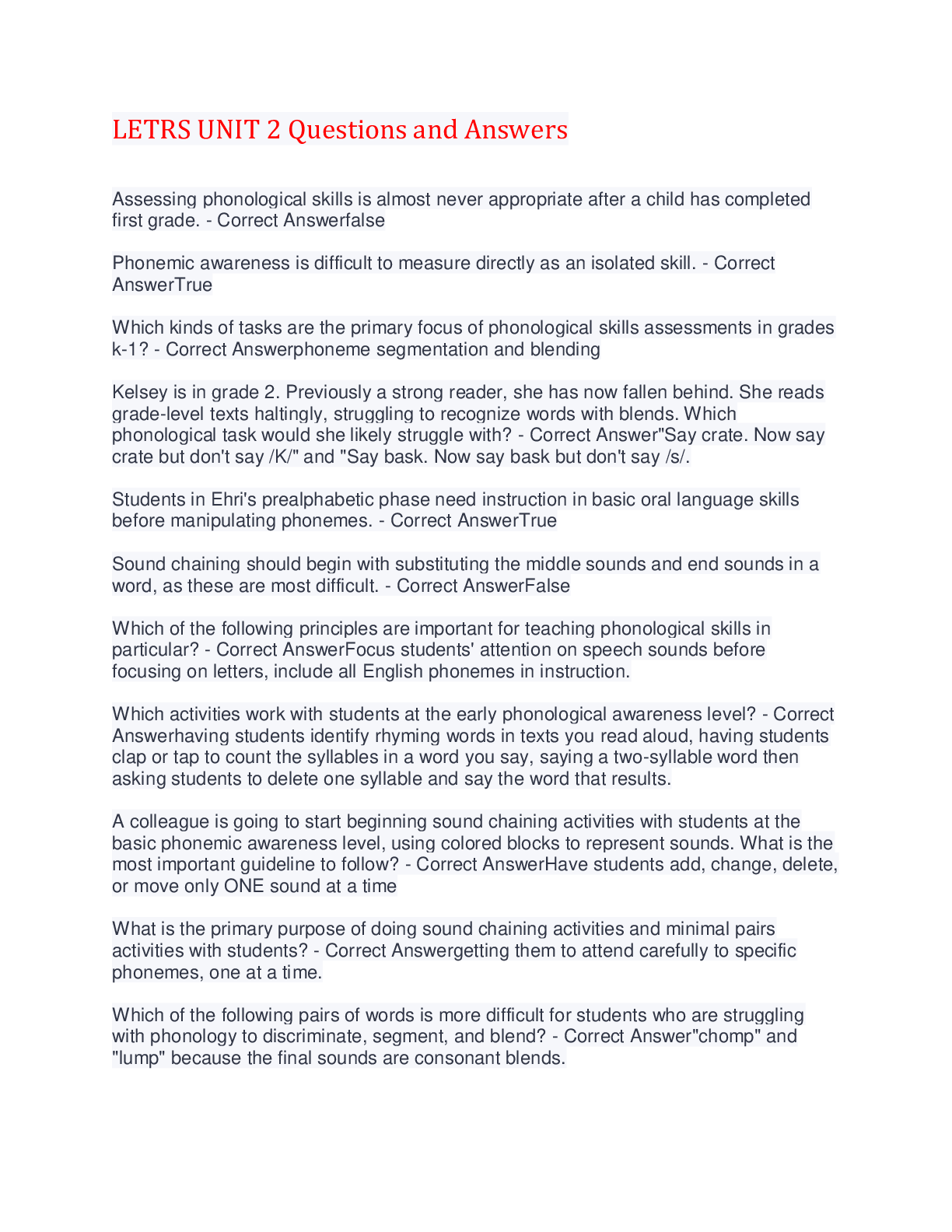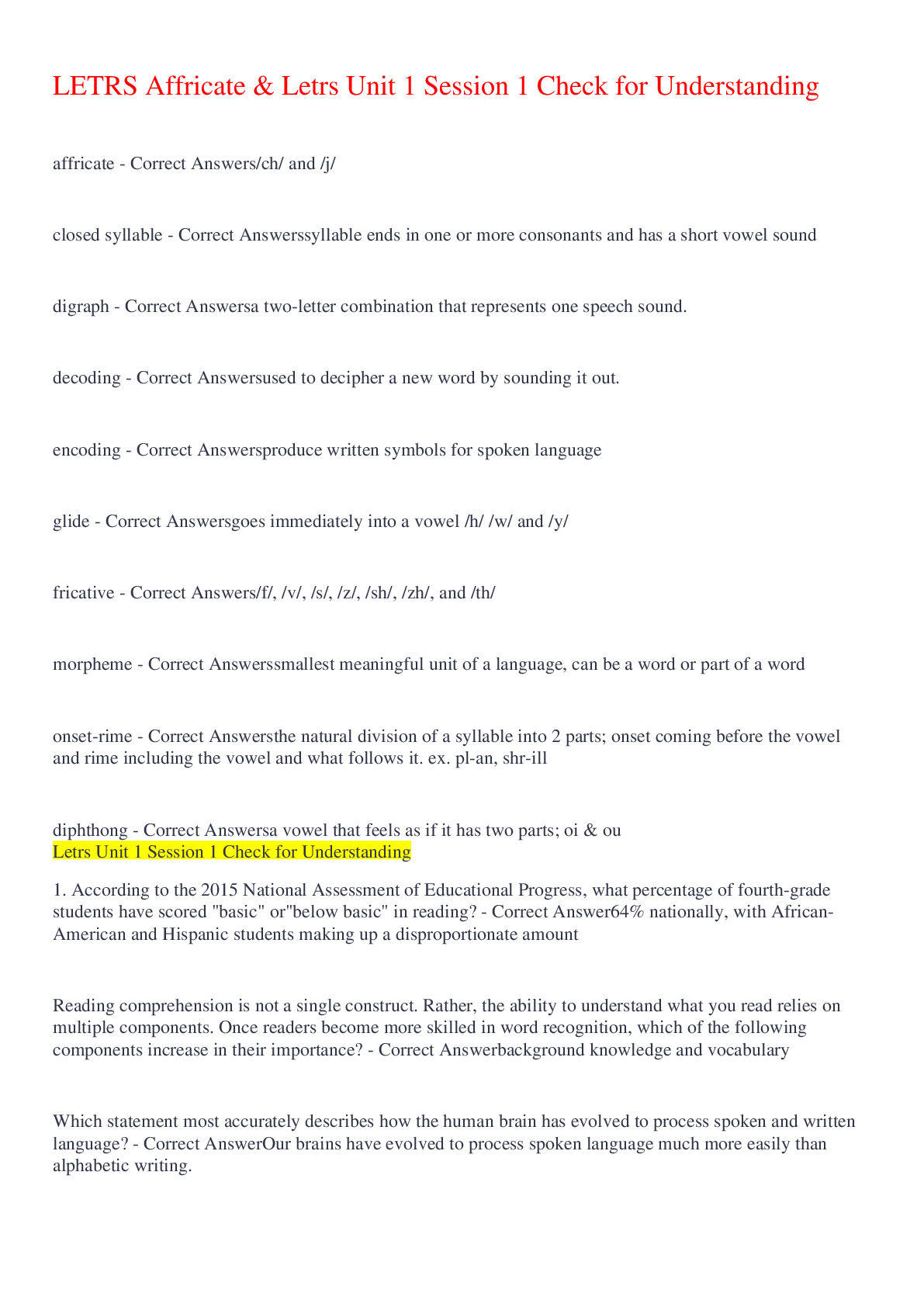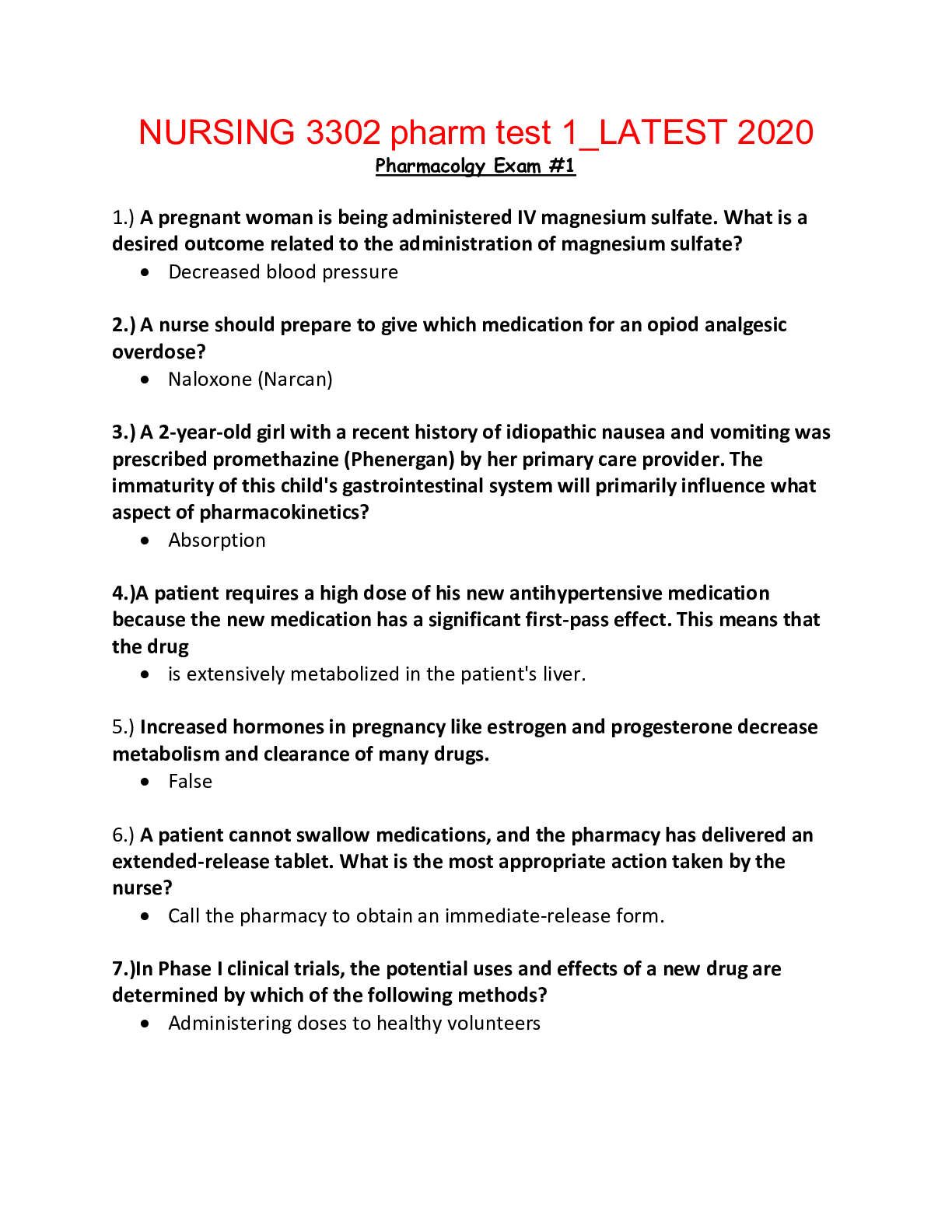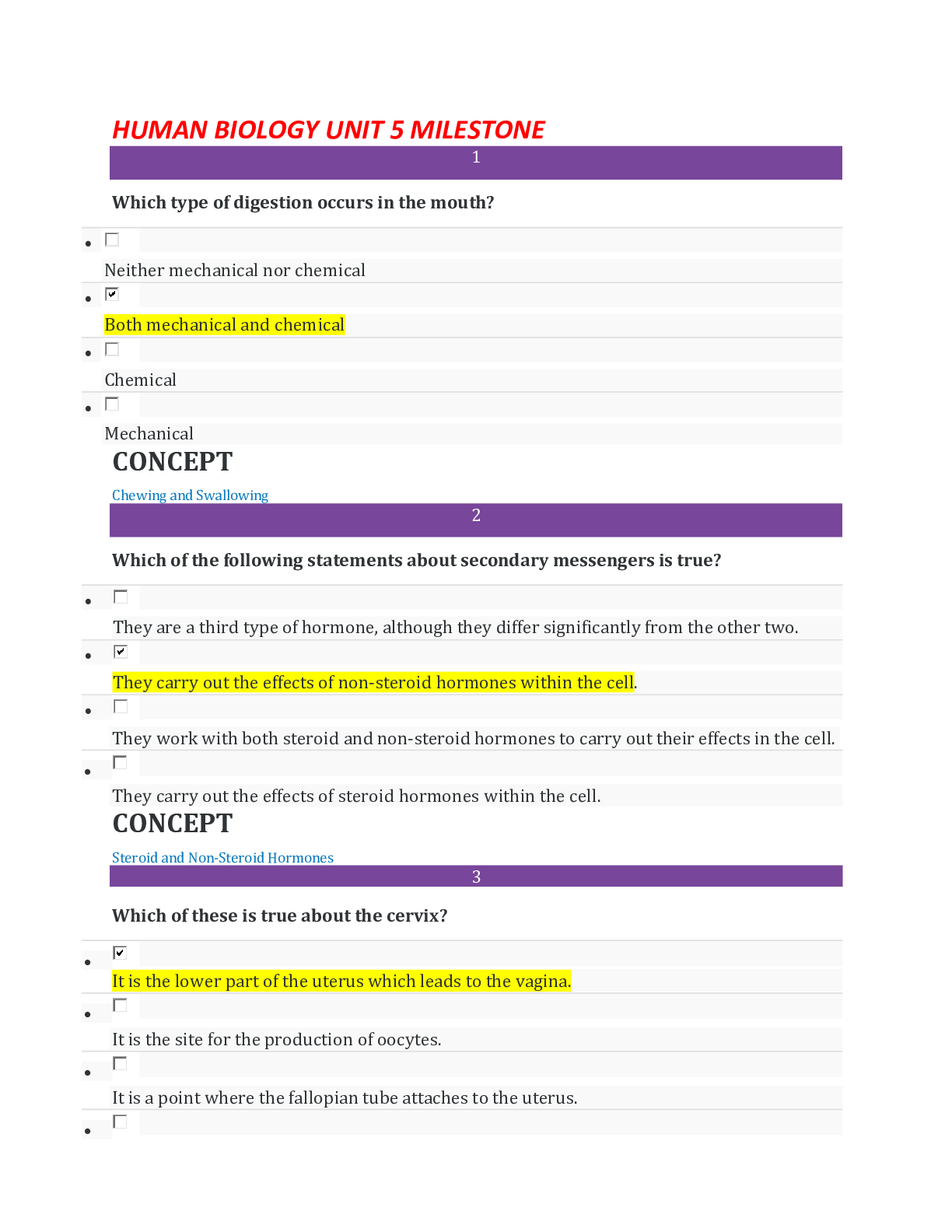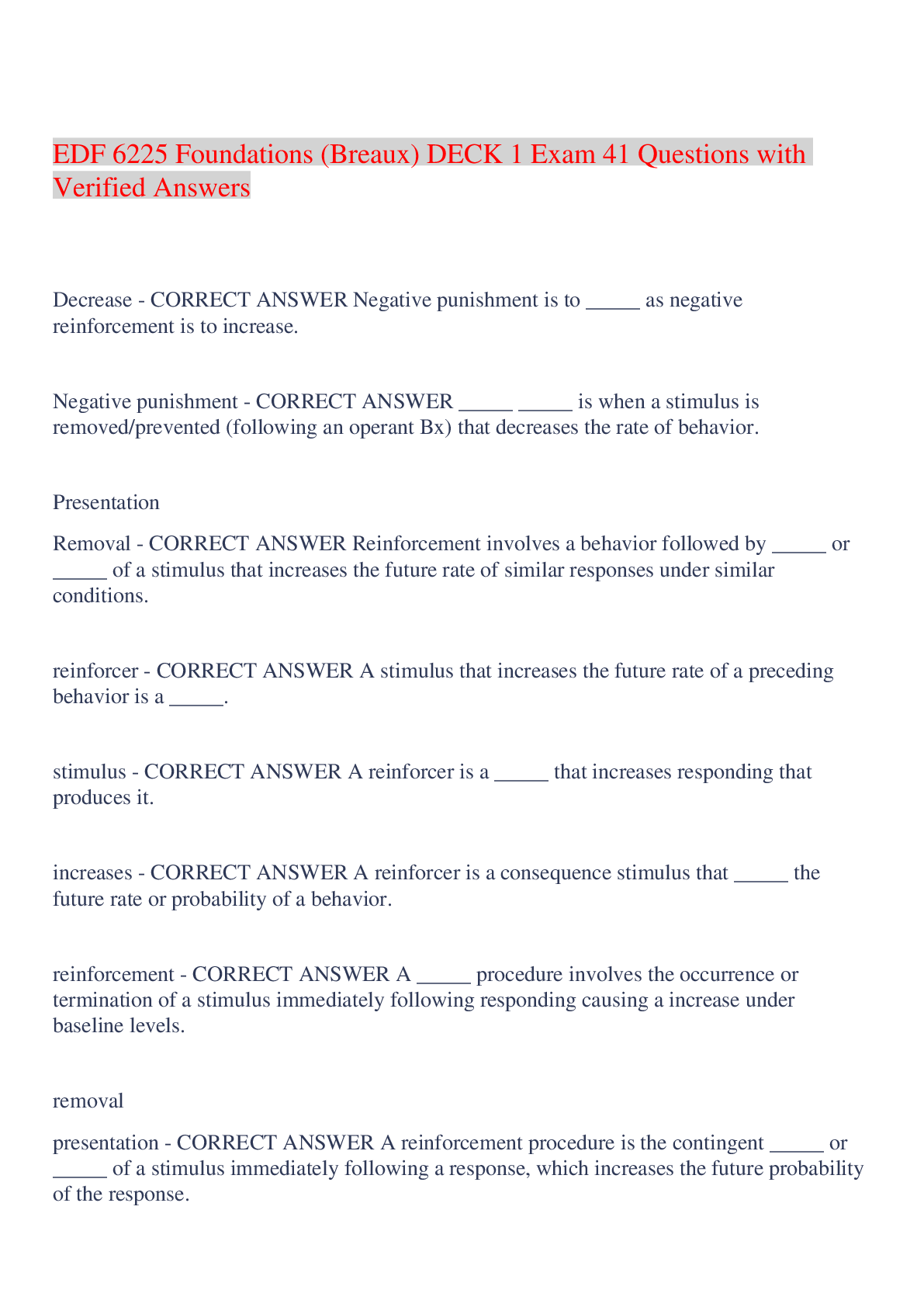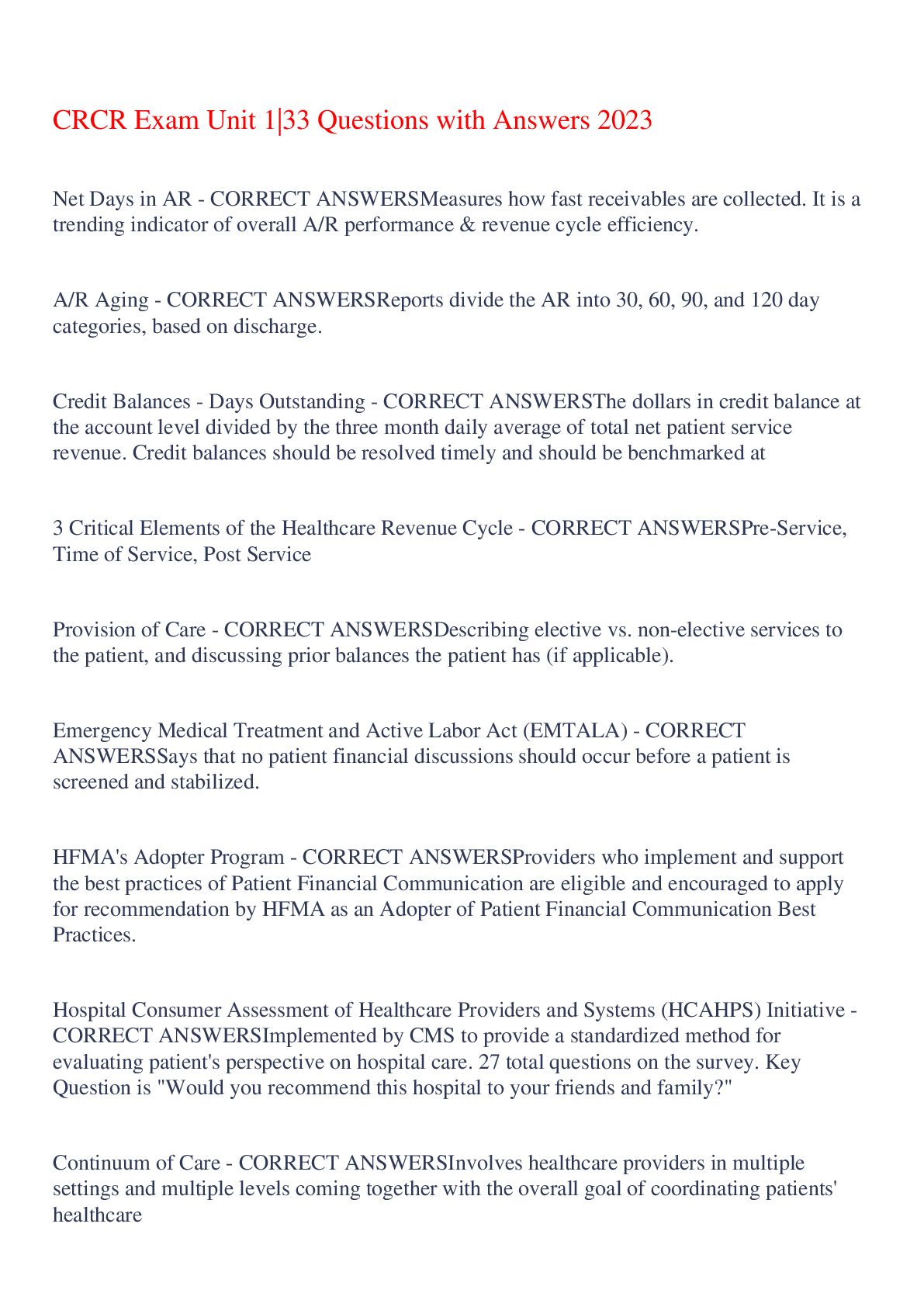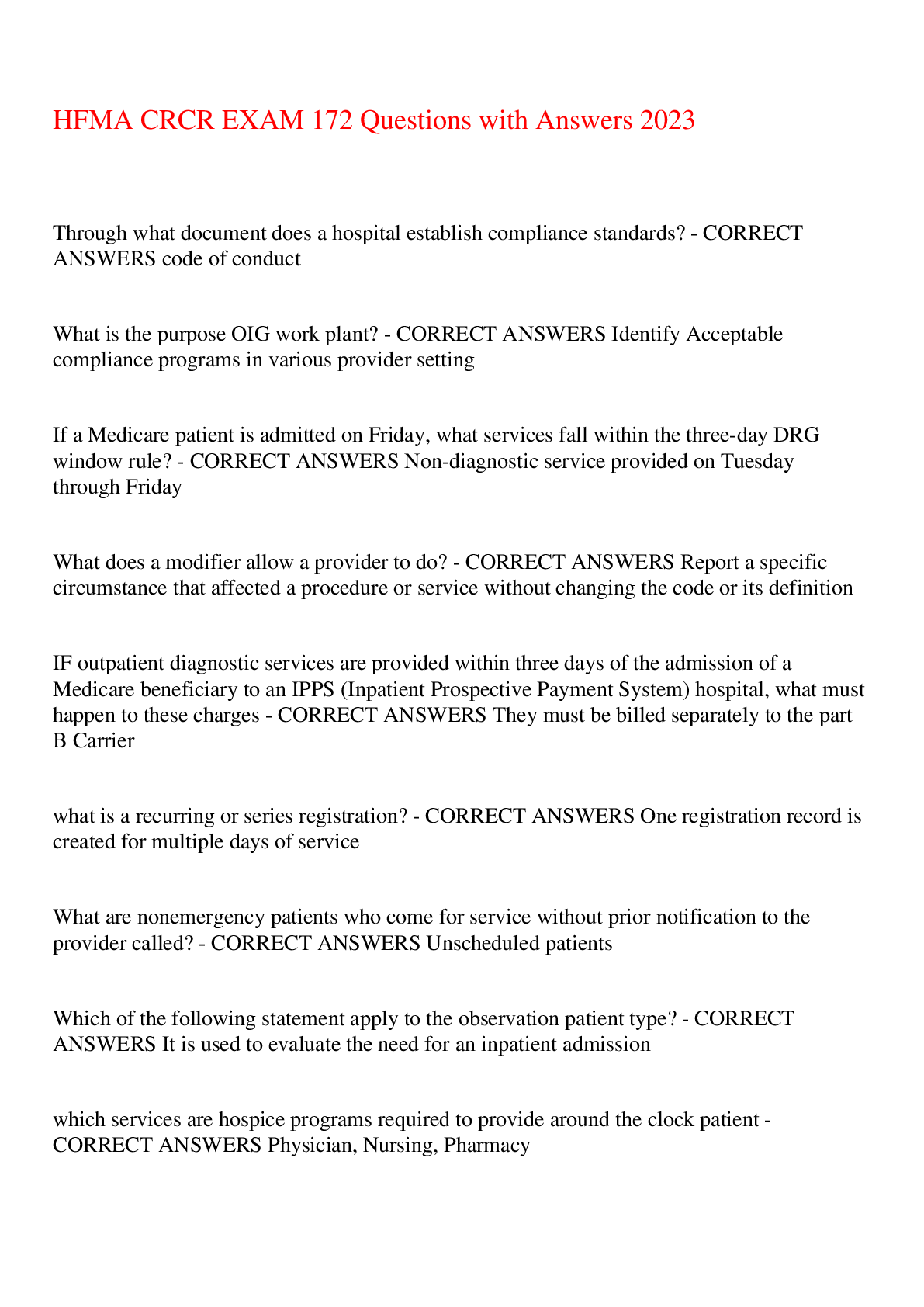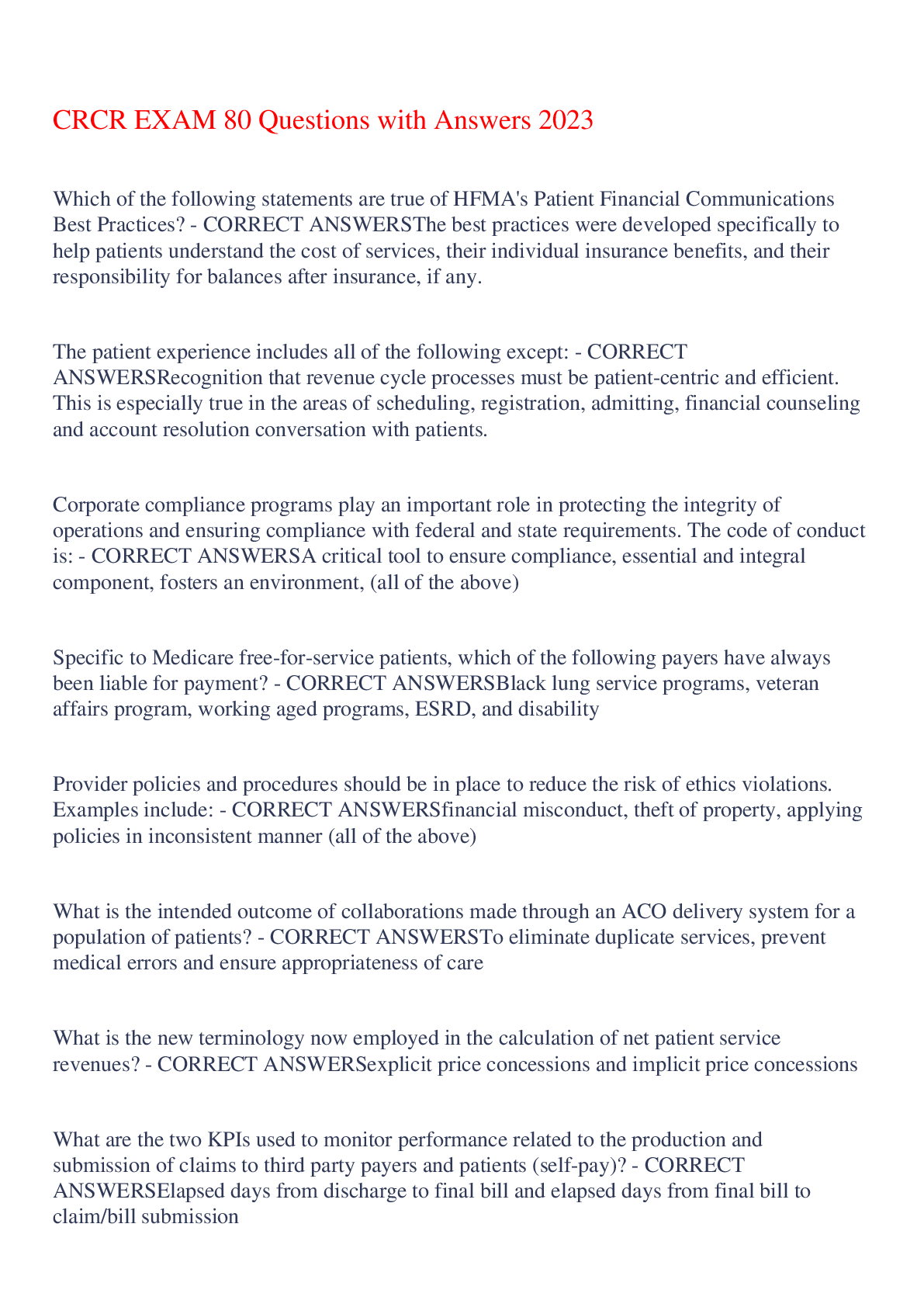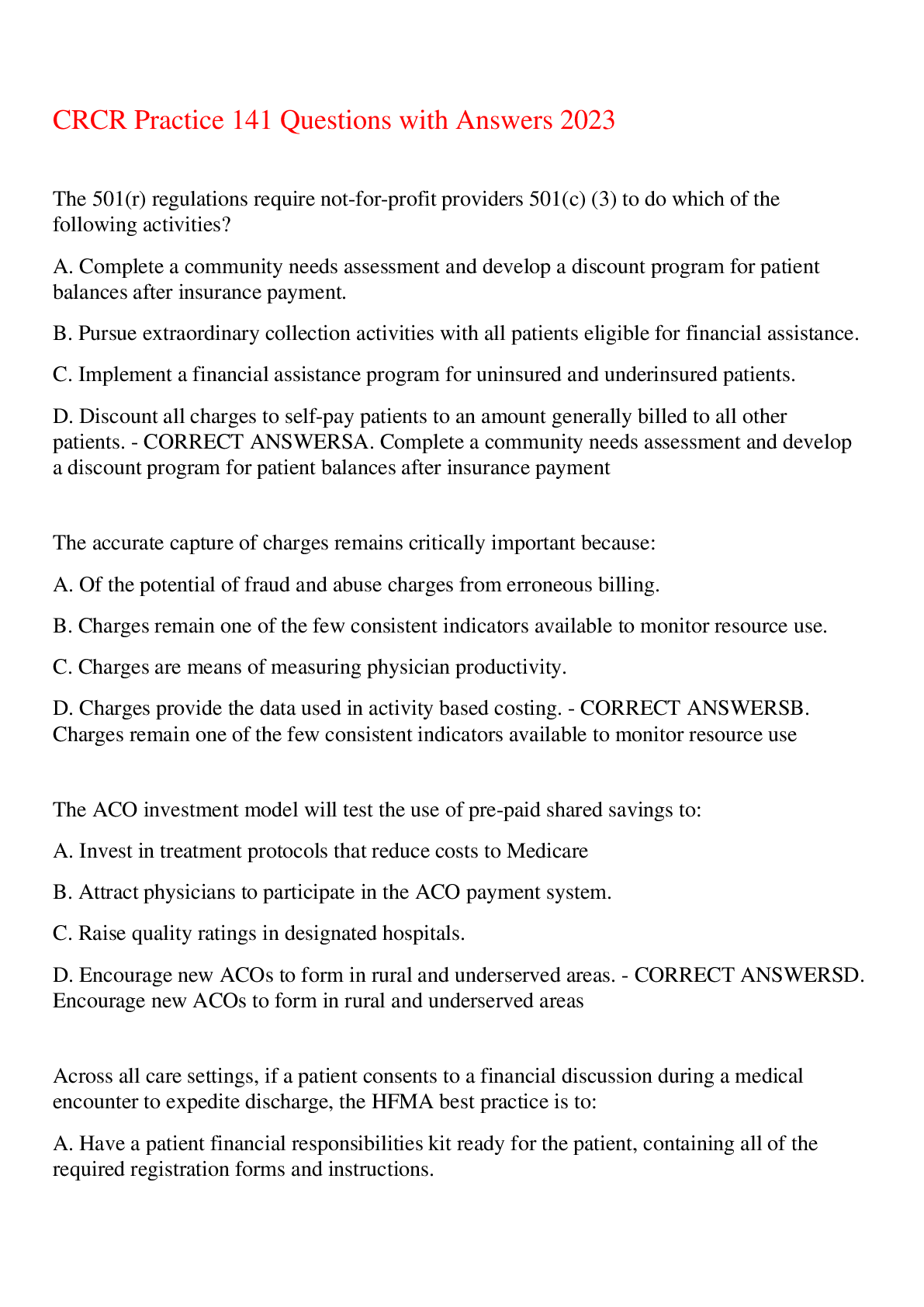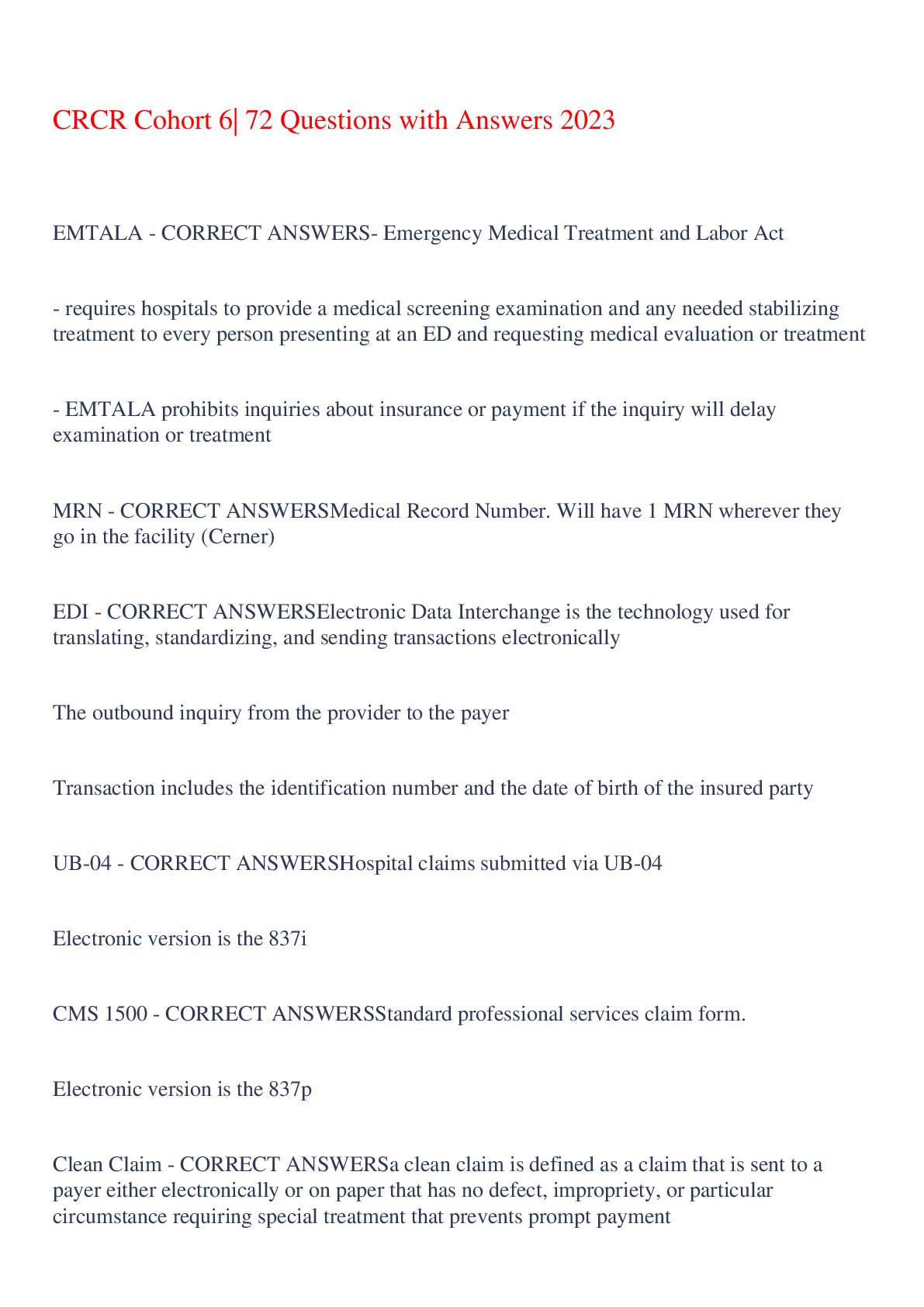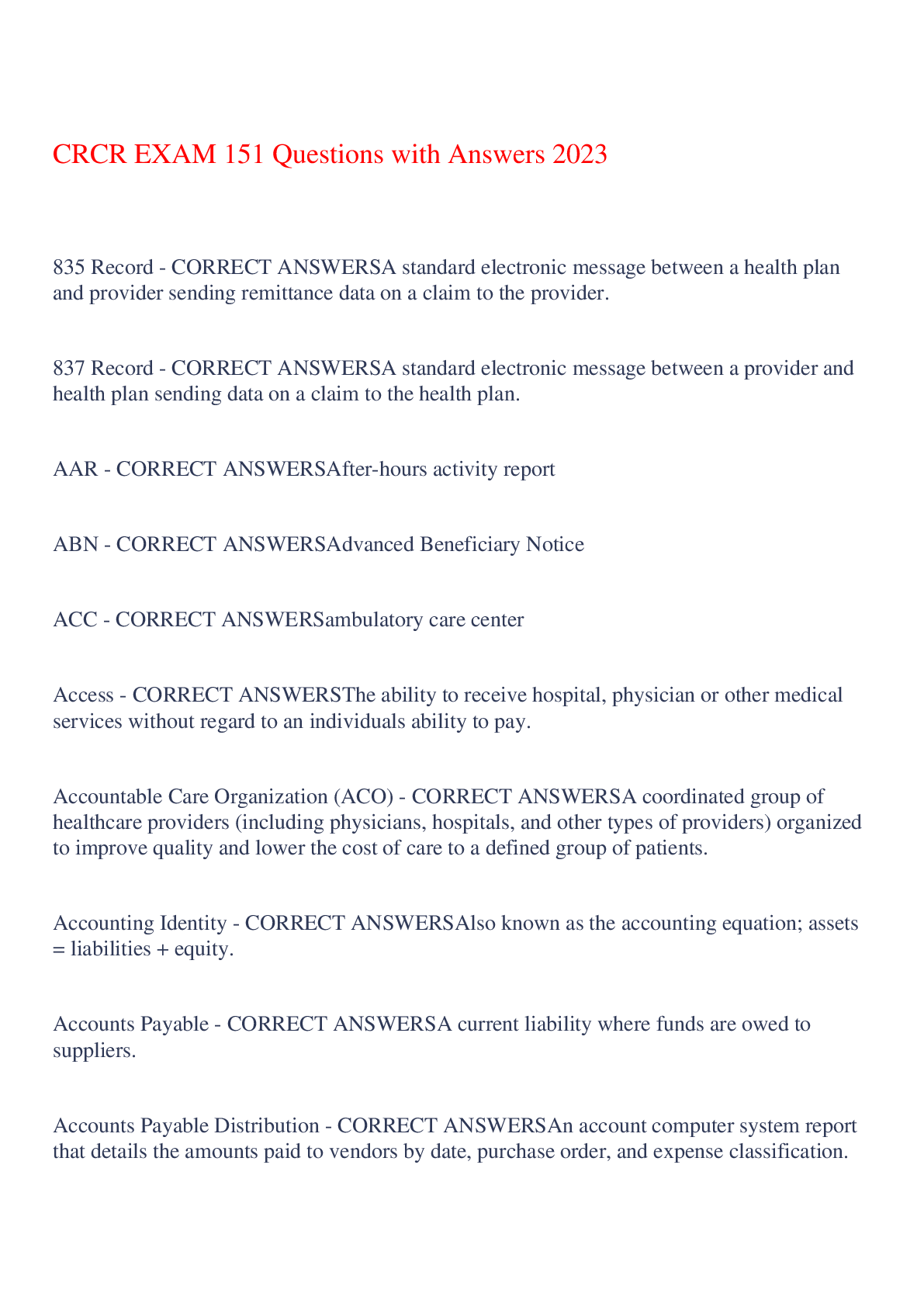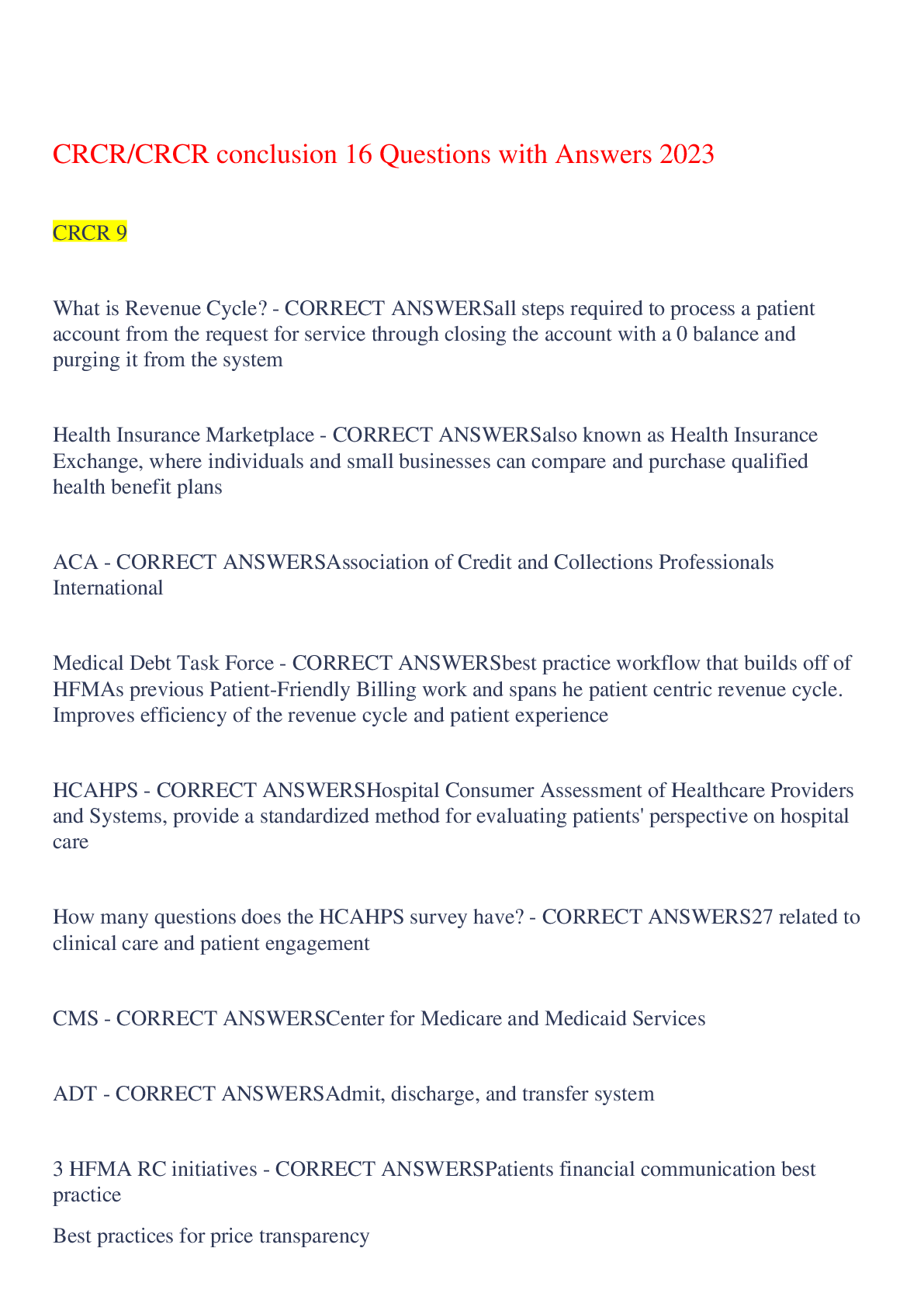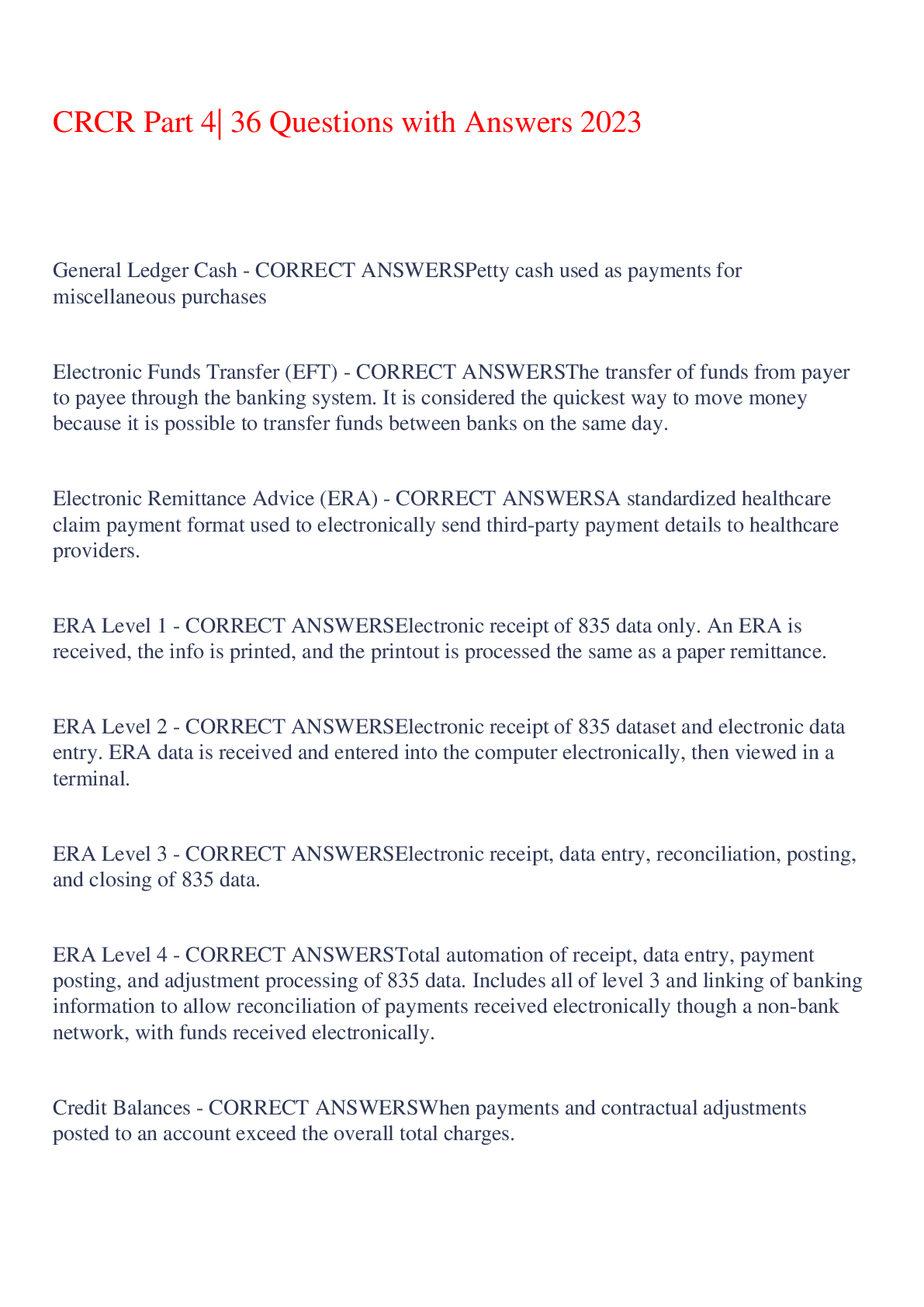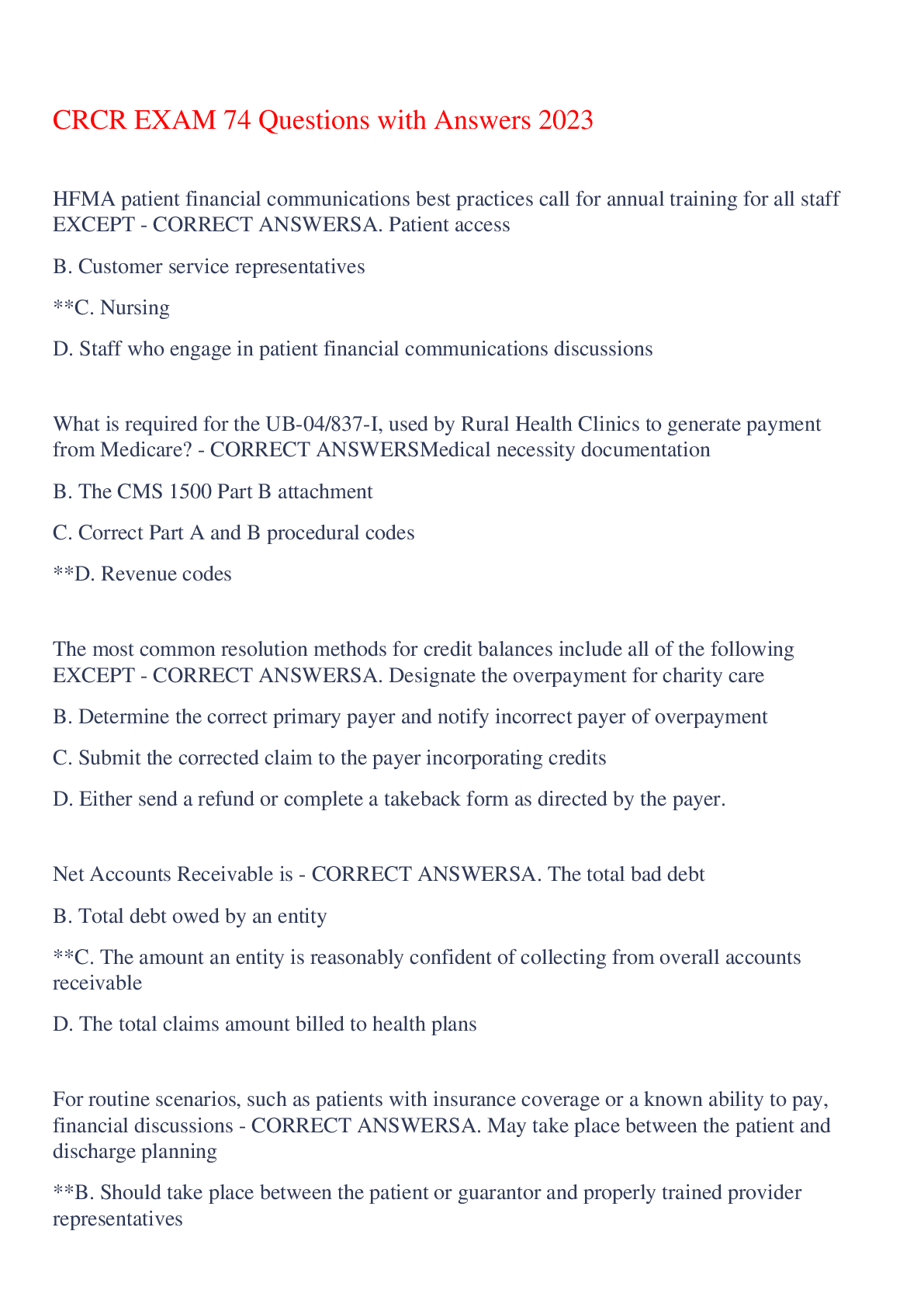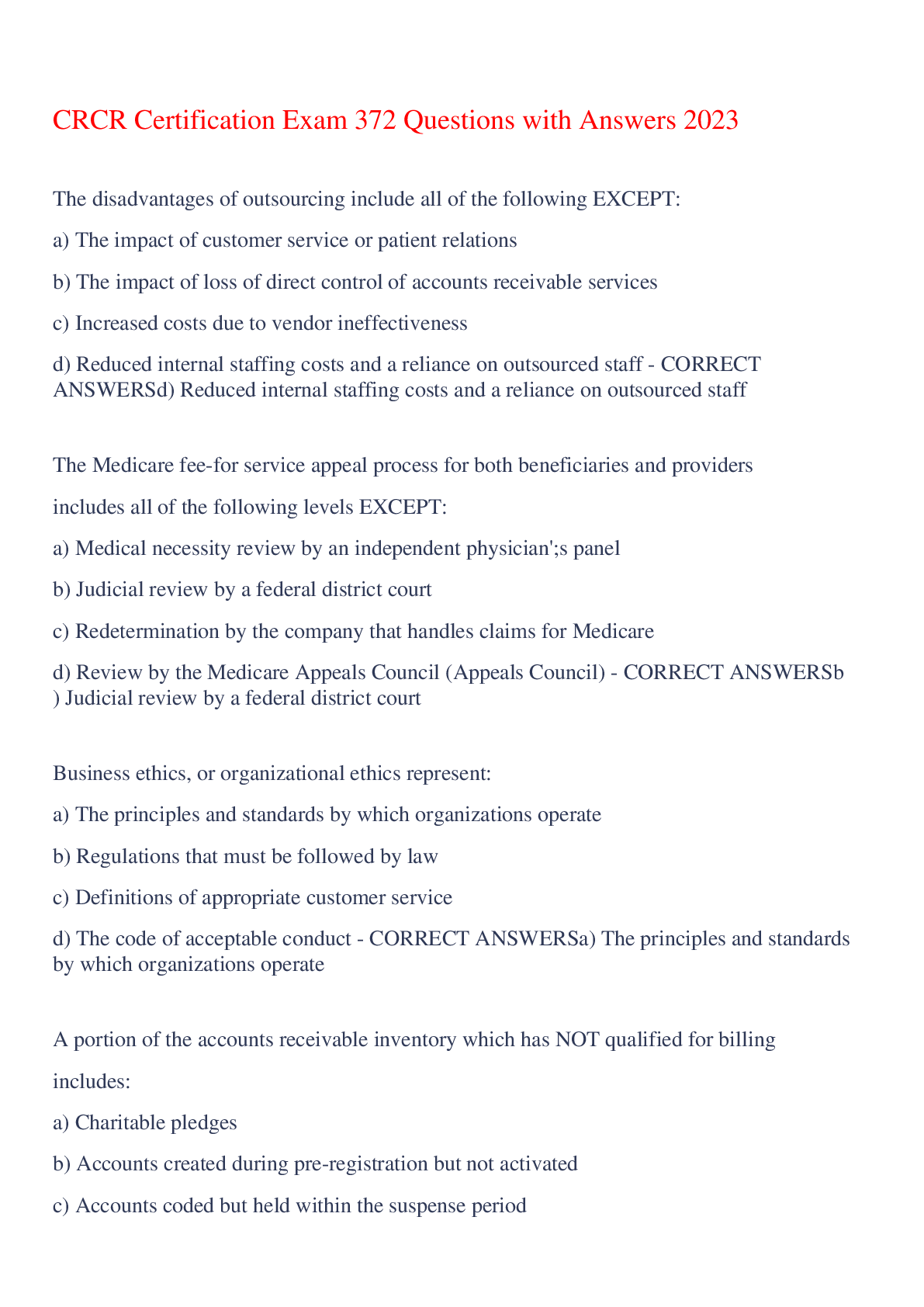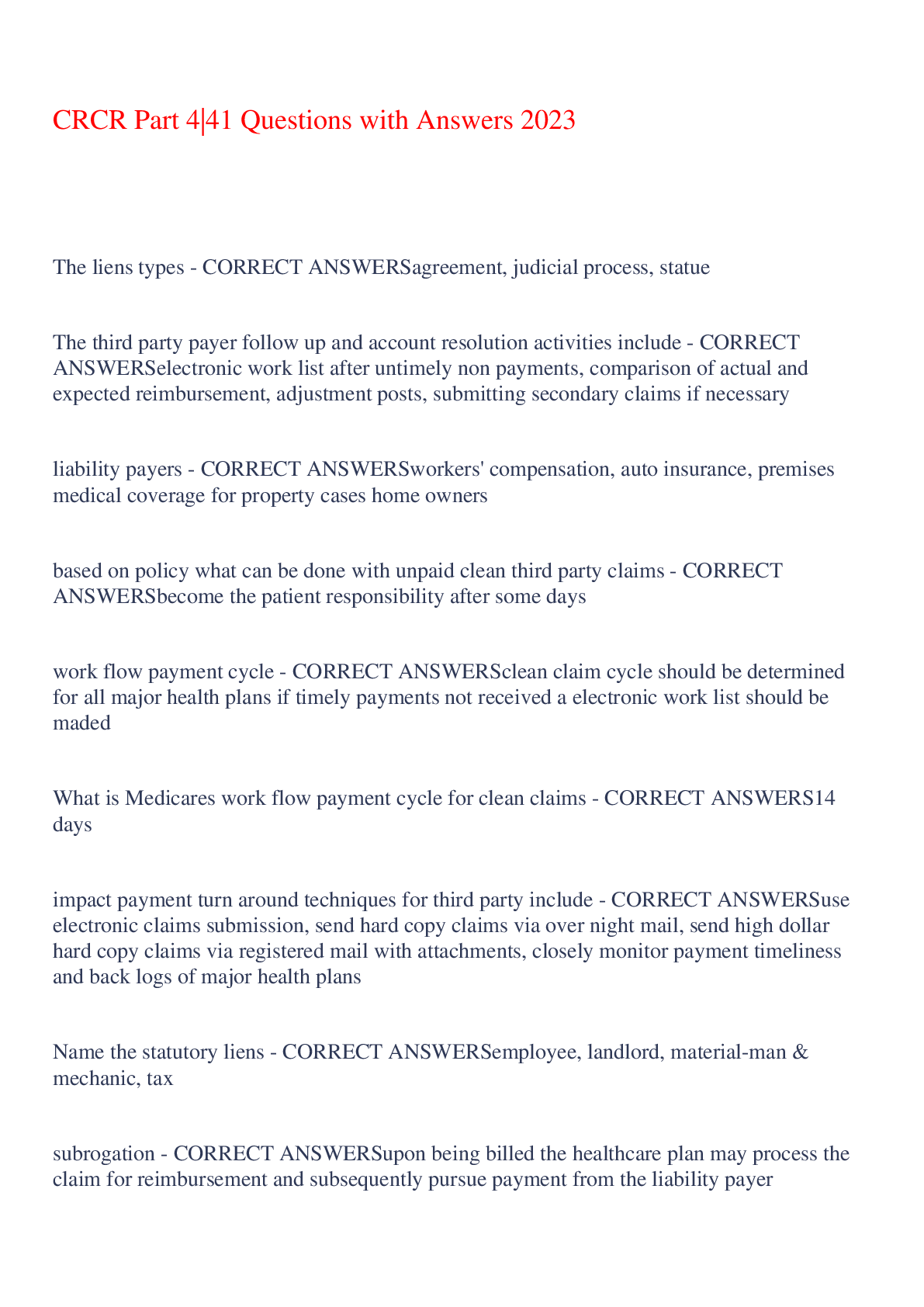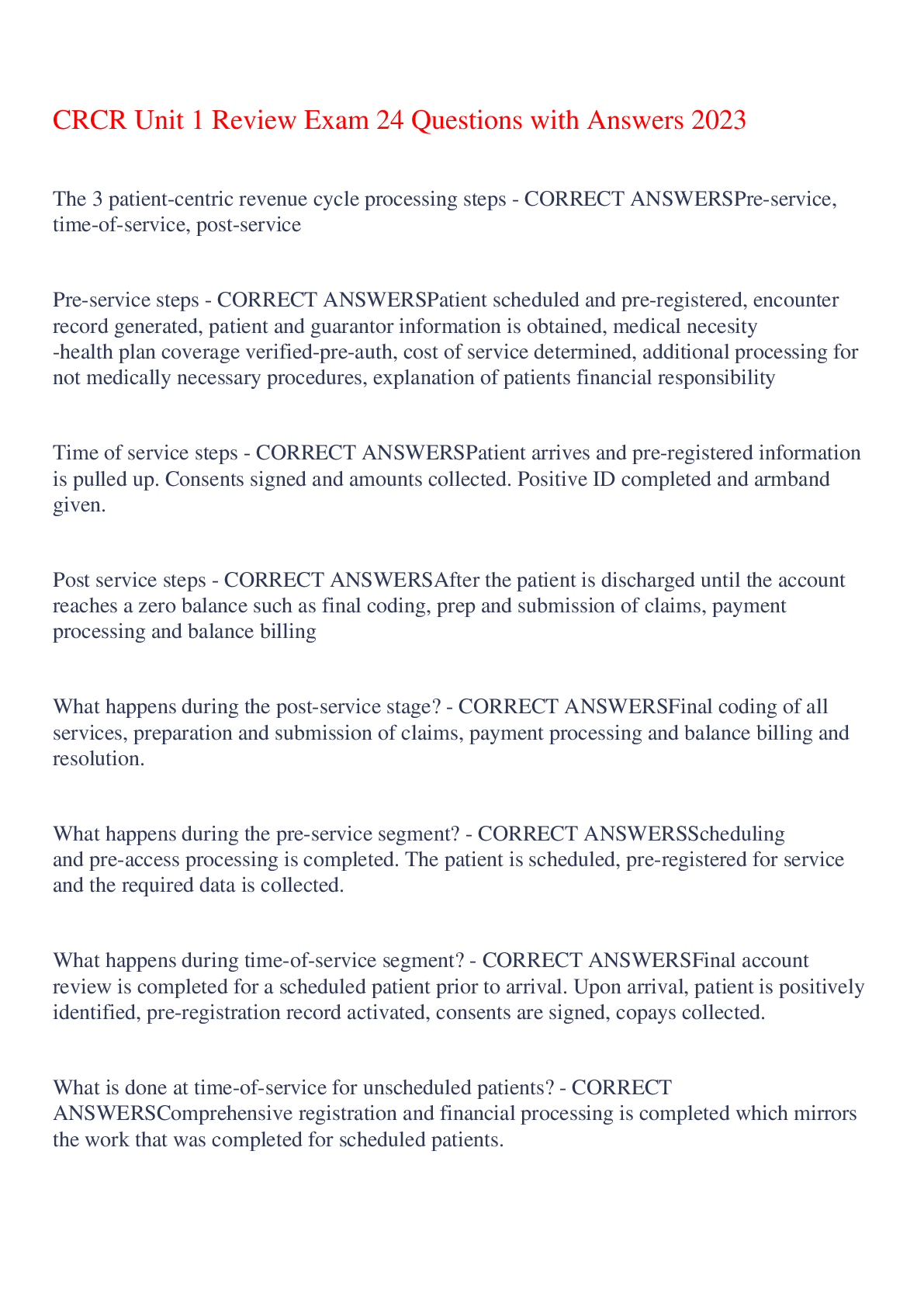MGMT 441 Exam 1|59 Questions with Answers 2023,100% CORRECT
Document Content and Description Below
MGMT 441 Exam 1|59 Questions with Answers 2023 Strategy - CORRECT ANSWER A firms theory about how to gain competitive advantages What strategies are based on - CORRECT ANSWER *Accurate predictio... n / assumption about the competition in the industry. *Systematic analysis of external environment and internal resources Competitive Advantage - CORRECT ANSWER Creating more economic value than rival firms Types of measures of Competitive Advantage - CORRECT ANSWER Accounting Ratios Economic Measures Economic Value - CORRECT ANSWER perceived benefits gained by customers of a product - total costs of the product Willingness to Pay (WTP) - CORRECT ANSWER perceived benefits gained by customer from a product determines the consumer's ___________________ Profitability Ratios - CORRECT ANSWER RoA, RoS, RoE, profit margin, earnings per share Liquidity ratios - CORRECT ANSWER Current ratio, Quick ratio Leverage ratios - CORRECT ANSWER Debt to assets, debt to equity, assets to equity Activity Ratios - CORRECT ANSWER Asset turnover, inventory turnover Competitive Advantage Position - CORRECT ANSWER Above normal economic performance. Return > Costs of capital Competitive Parity Position - CORRECT ANSWER Normal economic performance. Return = Costs of capital Competitive Disadvantage Position - CORRECT ANSWER Below normal economic performance The Strategic Management Process - CORRECT ANSWER A sequential set of analyses and choices that can increase the likelihood a good strategy being chosen Steps in The Strategic Management Process - CORRECT ANSWER Mission Objectives Internal / External Analysis Strategic Choice Strategy Implementation Mission / Vision - CORRECT ANSWER A firm's long-term purpose; defines what a firm aspires to be. Misson may be positively associated with firm performance - CORRECT ANSWER Visionary firms - firms whos mission clearly captures their aspirations and permeates all that they do Mission may harm firm performance - CORRECT ANSWER Some firms' mission is not consistent with the economic realities facing the firm Mission may not affect firm performance - CORRECT ANSWER Some firms' mission is disconnected to behaviors or does not say anything unique of about the firm Objectvies - CORRECT ANSWER Specific targets a firm can use to evaluate the extent to which it is realizing its mission High Quality Objectives - CORRECT ANSWER Connect to the firm's mission Precise & measurable Address crucial issues Challenging but realistic Specify a time period Financial Objectives - CORRECT ANSWER Objectives that relate to a firm's financial performance Strategic Objectives - CORRECT ANSWER Objectvies that relate to a firm's strategy and competitiveness Intended Strategy - CORRECT ANSWER A strategy a firm thought it was going to pursue Emergent Strategy - CORRECT ANSWER A strategy that emerges over time or that has been radically reshaped once implemented. Necessary to respond to internal and external changes. Realized Strategy - CORRECT ANSWER The strategy a firm is actually pursuing General Environment - CORRECT ANSWER Broad trends in the context within which a firm operates that can have an impact on the firm Parts of the General Environment - CORRECT ANSWER Legal & Political Conditions Economic Climate Technological Change Demographic Trends Cultural Trends International Events Broad trends - CORRECT ANSWER In the general environment, these can create threats and/or opportunities Structure-Conduct-Performance (SCP) model - CORRECT ANSWER Focuses on the nature of competition within an industry 5 Forces Model - CORRECT ANSWER Considers other 4 competitive forces that are outside of but exert pressure on the industry. Can reduce revenue and / or increase the costs of firms in the industry. Pieces of the 5 forces model - CORRECT ANSWER Rivalry, Buyers, Substitutes, New Entry, Suppliers New Entrants - CORRECT ANSWER firms recently entered or are planning to enter Substitutes - CORRECT ANSWER Products from outside the industry that meet similar customer needs Complementor - CORRECT ANSWER Customers perceived more value in focal firm's product when it is combined with another product (Smart phones & apps). Performance can be positive or negative. Types of industry - CORRECT ANSWER Fragmented Emerging Mature Declining Internal Analysis - CORRECT ANSWER Provides a comparative look at a firm's resources and capabilities Resources - CORRECT ANSWER Tangible & intangible assets a firm controls Capabilities - CORRECT ANSWER A subset of resources that enable a firm to take full advantage of other resources Categories of resources - CORRECT ANSWER Financial Physical Human Organizational 2 critical assumptions of the Resource Based View (RBV) - CORRECT ANSWER Resource Heterogeneity Resource Immobility Resource Heterogeneity - CORRECT ANSWER The resource bundles of firms are different from each other and some firms are more skilled in accomplishing certain activities than rivals. Resource Immobility - CORRECT ANSWER It may be costly / difficult for firms without certain resources to acquire or develop them. 2 forms of imitation - CORRECT ANSWER Direct duplication Substitution Barriers to imitation - CORRECT ANSWER Unique Historical Conditions Casual Ambiguity Social Complexity Patents Unique Historical Conditions - CORRECT ANSWER a firm developed its resources at a low cost because of unique historical conditions. (first mover advantages) Casual Ambiguity - CORRECT ANSWER Causal links between resources and competitive advantage may not be understood. Social Complexity - CORRECT ANSWER some resources or capabilities are socially complex. (trust, culture, relationships) Components of a Firm's Organization - CORRECT ANSWER Formal reporting structures Formal & informal management control system Compensation policies Competitive Parity - CORRECT ANSWER Valuable to a firm but not rare or hard to imitate Temporary Competitive advantage - CORRECT ANSWER Valuable and rare, but not hard to imitate Sustainable Competitive Advantage - CORRECT ANSWER Passes all VRIO frameworks. Generic Business Level Strategies - CORRECT ANSWER Cost Leadership Product Differentiation Cost Leadership - CORRECT ANSWER Competitive advantage comes from achieving a lower cost and the same WTP. Product Differentiation - CORRECT ANSWER Competitive advantage comes from achieving a higher consumer's perceived value of the firms products / services Sources of Cost Leadership - CORRECT ANSWER Size Differences (econ of scale) Experience Differences (learning curve) Low-cost access to productive inputs Technological advantages independent of scale Policy choices Organizational Structure - CORRECT ANSWER Make it as simple as possible. Few layers, small corp. staff, narrow range of functions Management Control - CORRECT ANSWER Cost leadership Philosophy Tight cost control; quantitative cost goals Close supervision Compensation policies - CORRECT ANSWER Reward/goals/incentives based on cost reduction [Show More]
Last updated: 1 year ago
Preview 1 out of 7 pages
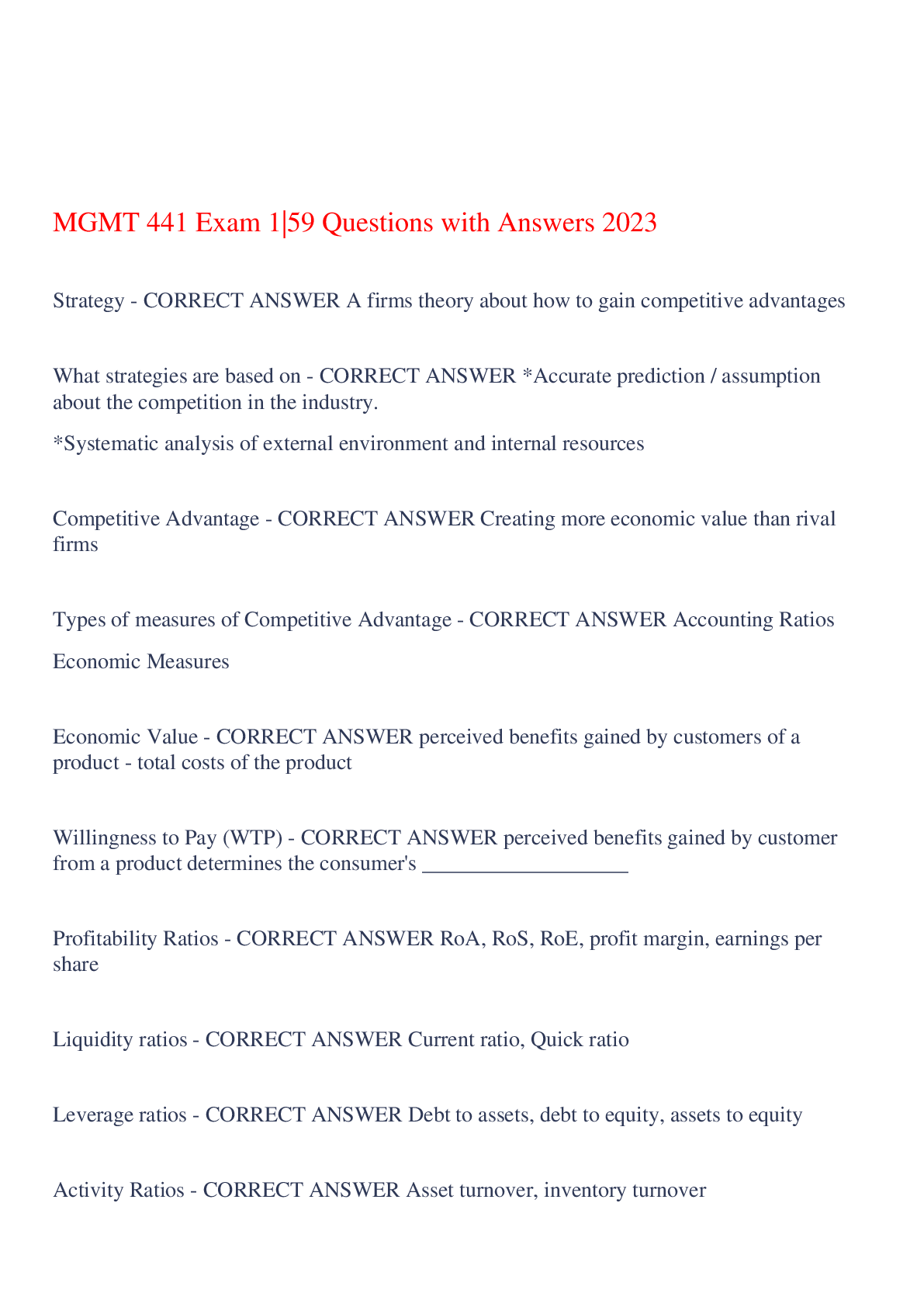
Buy this document to get the full access instantly
Instant Download Access after purchase
Buy NowInstant download
We Accept:

Reviews( 0 )
$9.50
Can't find what you want? Try our AI powered Search
Document information
Connected school, study & course
About the document
Uploaded On
Jul 03, 2023
Number of pages
7
Written in
Additional information
This document has been written for:
Uploaded
Jul 03, 2023
Downloads
0
Views
110


